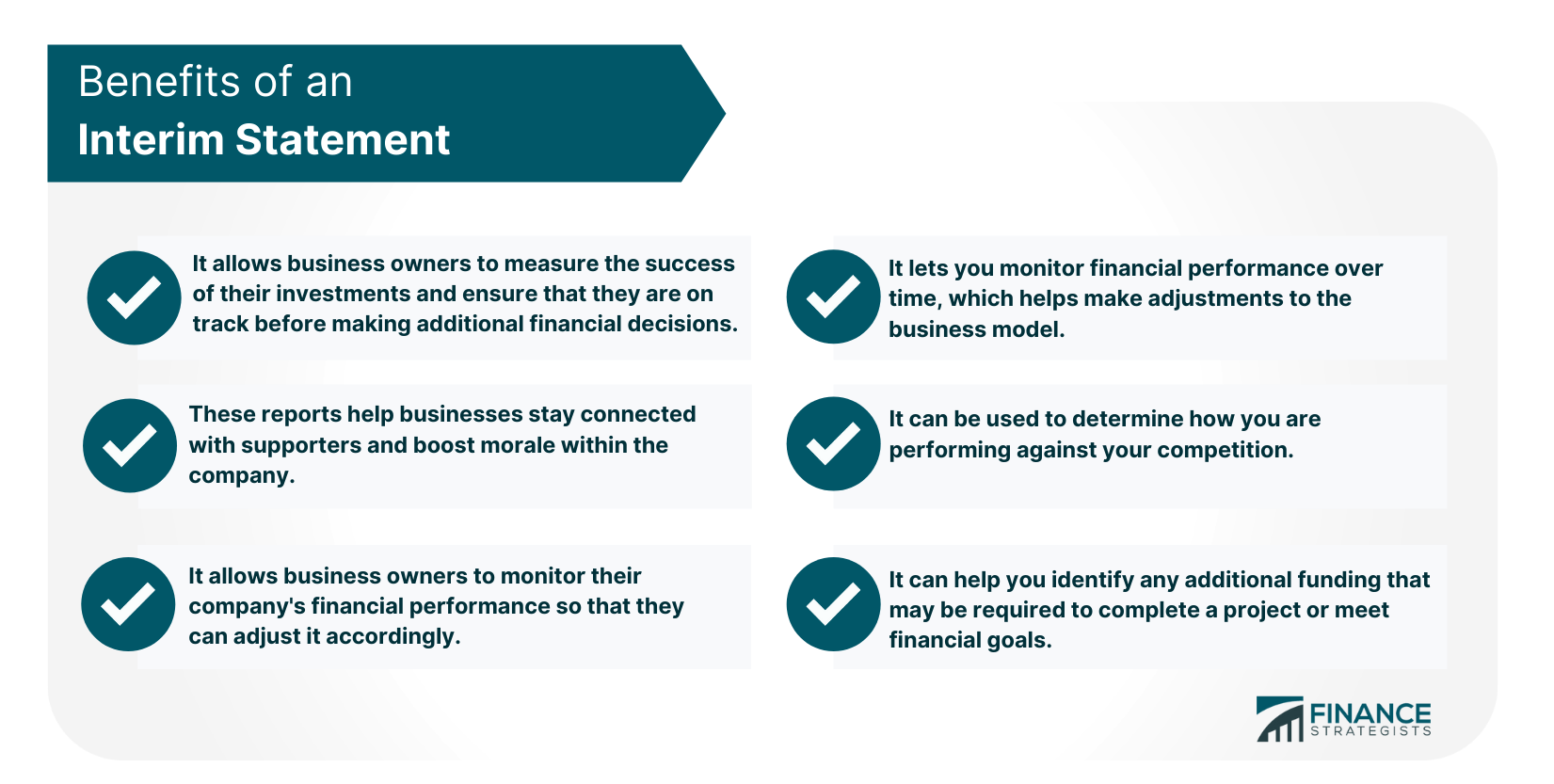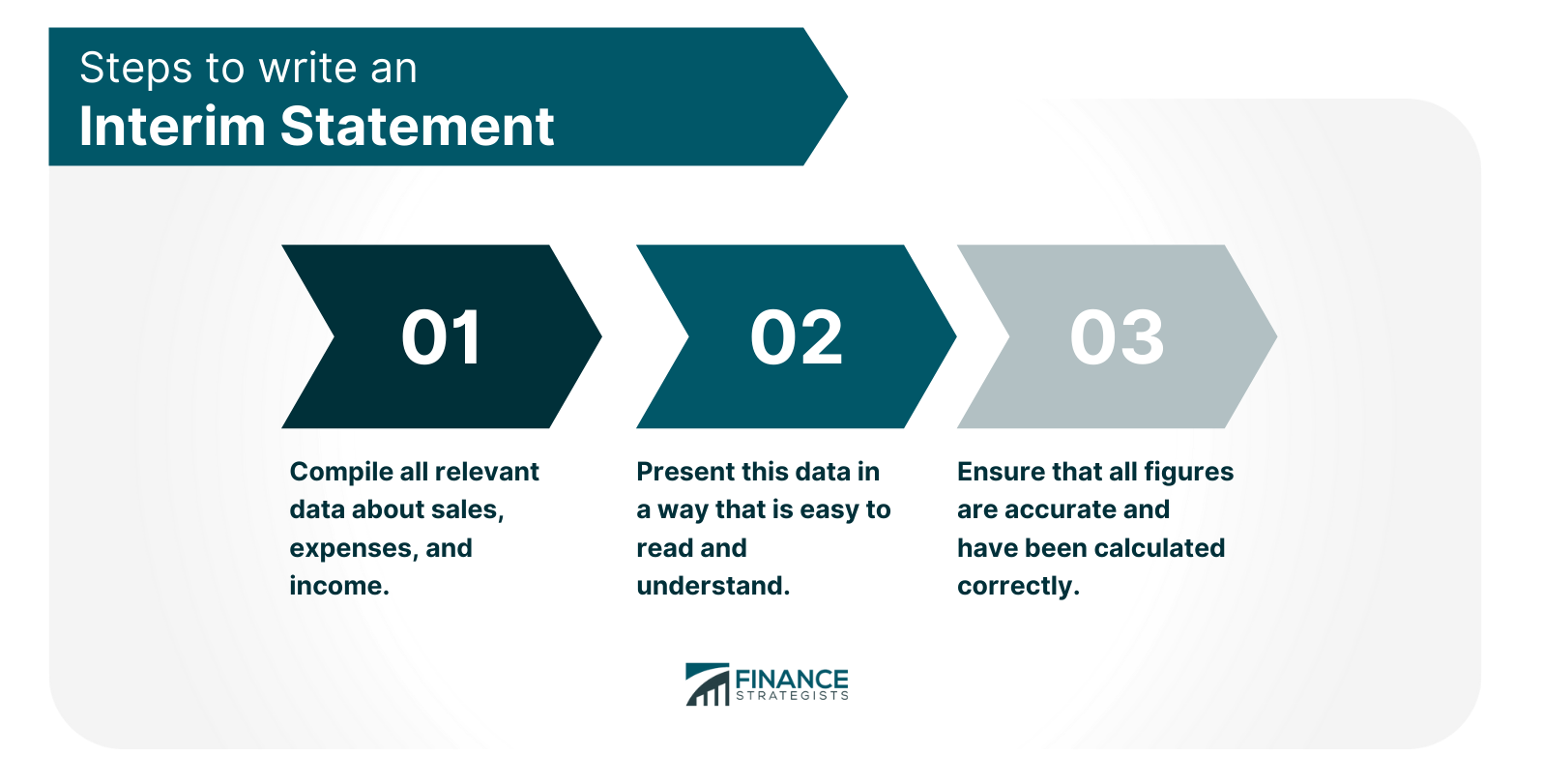An interim statement is a report used to summarize a company's financial performance over a specified period of time. An interim report is typically prepared monthly or quarterly, whereas the final report usually occurs at the end of each fiscal year. Interim statement is an important tool for businesses because it can be used to help monitor progress and make sure that everything is going according to plan. Interim statements can be useful in several ways. The benefits are: Interim statements should be used whenever a business has set out specific goals and milestones that need to be achieved to ensure that everything is going as planned. You can use it when you have a new product or service that needs to be launched. It is because, during this process, you can adjust your business model as necessary. Also, you would use this report when you are about to make a financial commitment, such as purchasing equipment or making investments. Another time to use interim statements is when you want to track the success of a business and compare its performance against other companies in similar industries. Lastly, you would use this type of report to identify whether or not your business is going in the right direction and determine if there are any adjustments that need to be made. The following steps will explain exactly what is involved in writing these types of reports: An interim statement report requires you to include all of the relevant data collected about sales, expenses, and income. This information should be divided into three different categories: It is important for you to format your report so that it can be easily understood by the reader, which includes: Lastly, before you finalize your interim statement report, it is important to ensure that the numbers included in each section have been accurately calculated. This means checking them against other sources if possible, such as sales records or previous financial statements. Some general guidelines include: Below is a sample template for a condensed interim consolidated statement of profit or loss and other comprehensive income. Link for the excel file of the template: Sample Template Benefits of an Interim Statement

When Should You Use Interim Statements?
Steps to Write an Interim Statement Report

Step 1: Compile all relevant data about sales, expenses, and income.
Step 2: Present this data in a way that is easy to read and understand.
Step 3: Ensure that all figures are accurate and have been calculated correctly.
General Guidelines for Using this Type of Report
Sample Template for an Interim Statement Report
Interim Statements FAQs
An interim statement reports on the financial performance of a business over time. It provides information about its sales, expenses, and income during specific periods of time (e.g., months or quarters).
This type of report can help you identify any additional funding required to complete a project or meet financial goals. It can also be used when tracking the success of a business and comparing its performance against other companies in similar industries. It is helpful for identifying whether your business is going in the right direction and if any adjustments need to be made.
You would typically use this type of report when planning on investing in assets or equipment within the next few months. It is best used when you want to compare your sales, income or expenses against other companies in similar industries. You would typically use an interim statement report to track overall performance trends for your business if you plan on investing money in assets or equipment within the next few months (e.g., a new inventory system).
There are three different types of financial statements included in an interim statement report: Profit and Loss Statement - this is used to show the business's overall performance during a specific period. Balance Sheet - this can help investors understand how much money your company has made or lost over time, whether you have more liabilities than assets (and if so, by how much), etc. Cash Flow Statement - helps determine where cash comes from and what is being spent on within the business. It also shows any changes that may occur throughout each month/quarter regarding its available cash balance.
An interim report is typically prepared monthly or quarterly, whereas the final report usually occurs at the end of each fiscal year. The most important difference between these two types of reports is that an interim statement only includes financial information for up to three months/quarters. In contrast, a final statement will include data from all 12 months to provide investors with more accurate results over time.
True Tamplin is a published author, public speaker, CEO of UpDigital, and founder of Finance Strategists.
True is a Certified Educator in Personal Finance (CEPF®), author of The Handy Financial Ratios Guide, a member of the Society for Advancing Business Editing and Writing, contributes to his financial education site, Finance Strategists, and has spoken to various financial communities such as the CFA Institute, as well as university students like his Alma mater, Biola University, where he received a bachelor of science in business and data analytics.
To learn more about True, visit his personal website or view his author profiles on Amazon, Nasdaq and Forbes.











